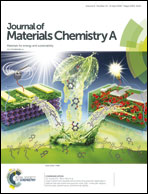Liquid nitrogen driven assembly of nanomaterials into spongy millispheres for various applications†
Abstract
In the development of nanotechnology, the creation of new nanomaterials consistently feeds back into efforts to design and fabricate novel macroscopic materials with specific properties. Despite recent progress in preparing numerous types of nanomaterials, it remains a prodigious challenge to assemble tiny building blocks into functional macroscale architectures suitable for practical applications. Herein, we report a facile strategy suitable for common nanomaterials, in which ice-templated assembly and liquid nitrogen-assisted rotation are coupled, for fast processing of uniform spongy millispheres with tunable microstructures. Such spheres possess a hierarchical structure with an interpenetrating, open-porous, urchin-like network and abundant external voids, which can be continuously fabricated on a large scale by employing an automatic propeller. To demonstrate the great potential of the unique three-dimensional network in the energy and environmental field, boron nitride plates and graphene based spheres are fabricated to be utilized in oil/solvent adsorption and supercapacitors, respectively. With such useful features, we believe that this strategy may serve as a valuable tool for the assembly of nanomaterials for various applications.



 Please wait while we load your content...
Please wait while we load your content...